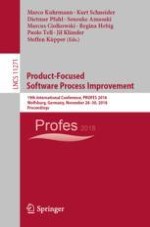2018 | Book
Product-Focused Software Process Improvement
19th International Conference, PROFES 2018, Wolfsburg, Germany, November 28–30, 2018, Proceedings
Editors: Dr. Marco Kuhrmann, Prof. Dr. Kurt Schneider, Dietmar Pfahl, Sousuke Amasaki, Marcus Ciolkowski, Prof. Dr. Regina Hebig, Dr. Paolo Tell, Jil Klünder, Steffen Küpper
Publisher: Springer International Publishing
Book Series : Lecture Notes in Computer Science
